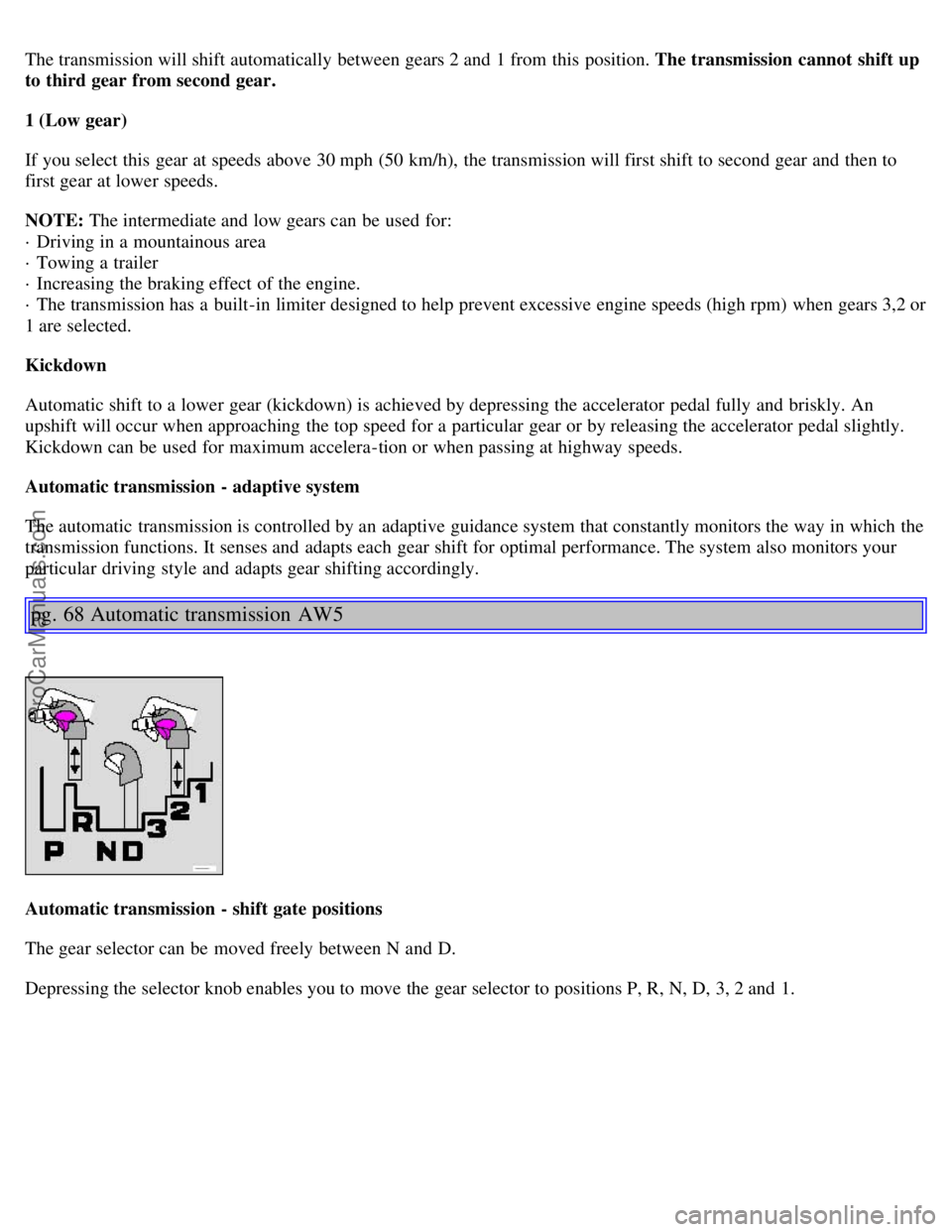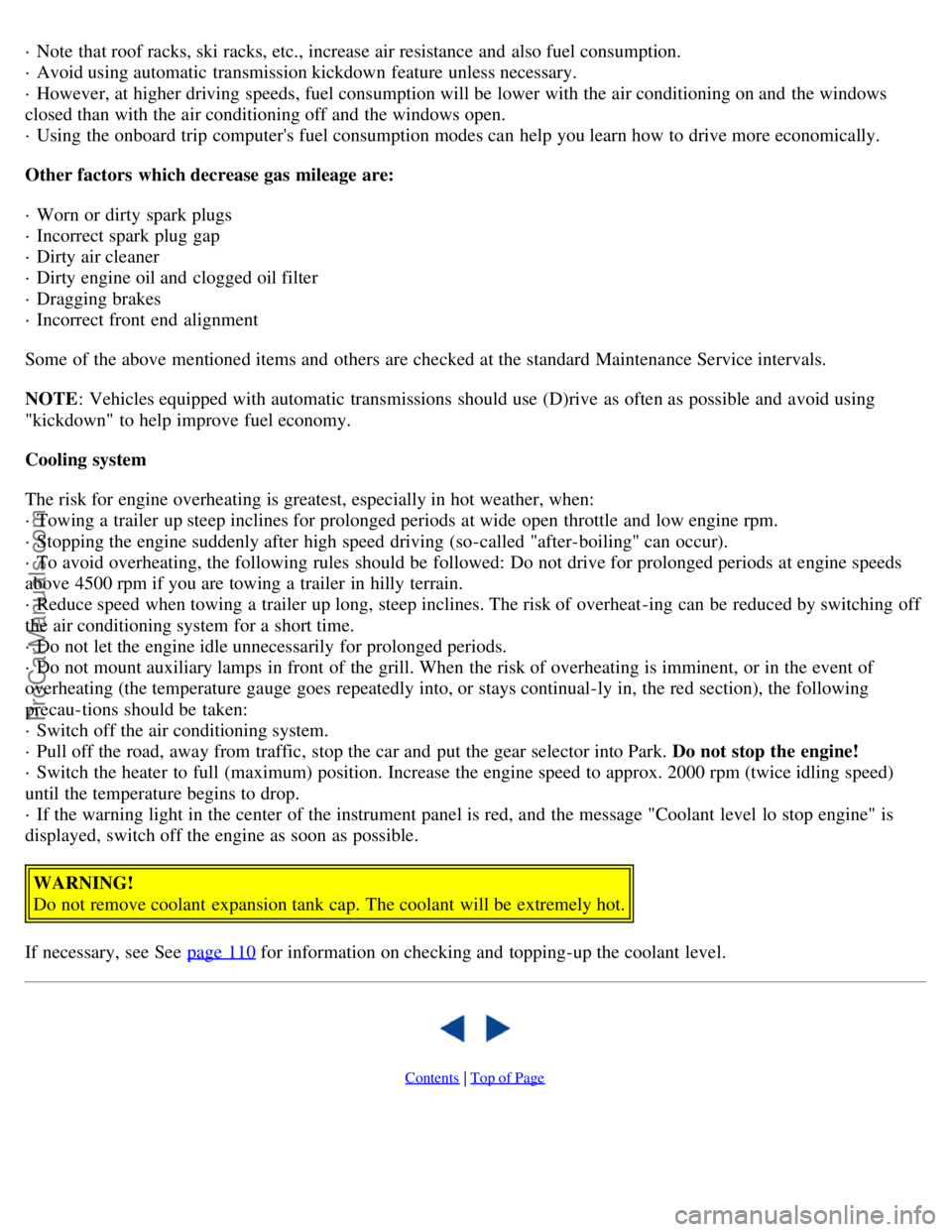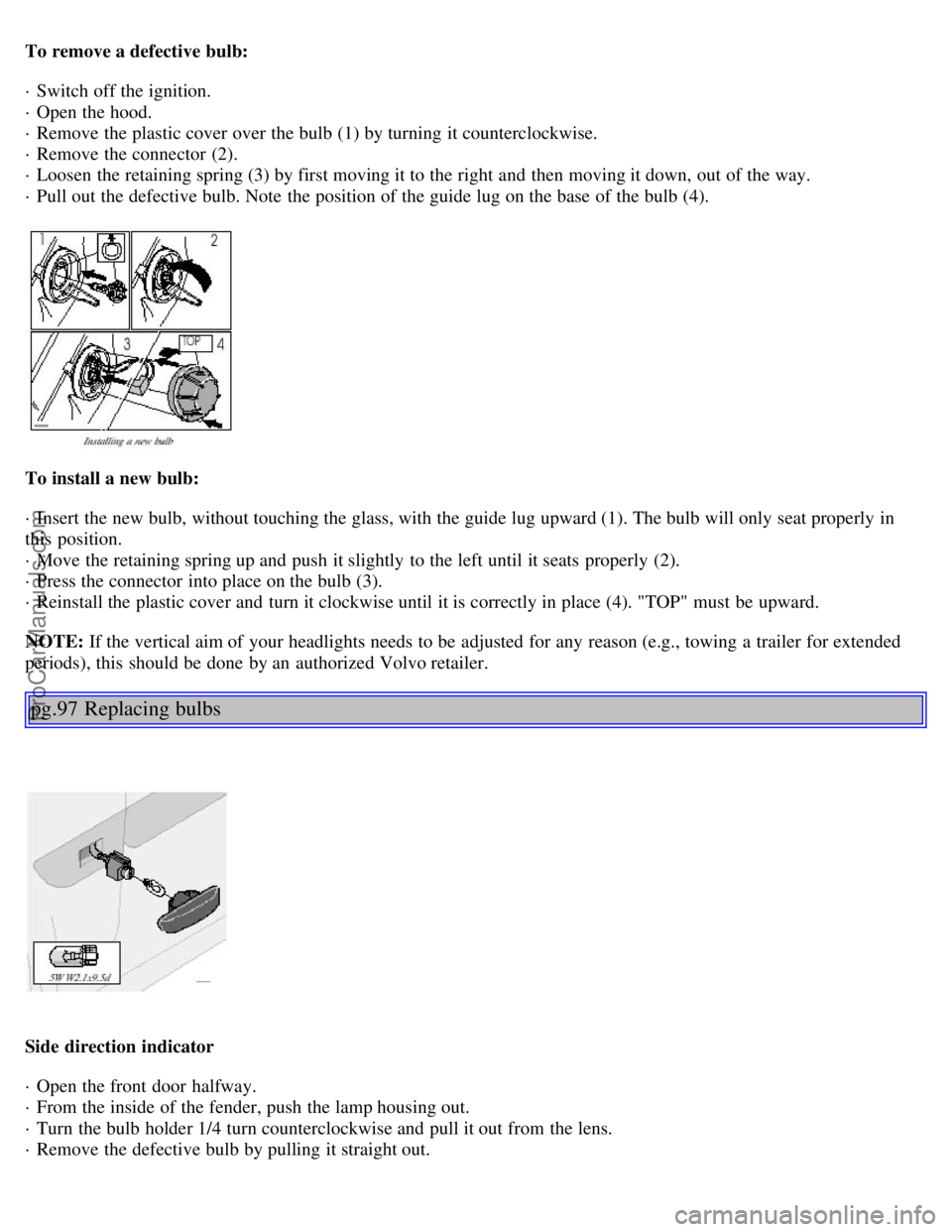2001 VOLVO S80 towing
[x] Cancel search: towingPage 22 of 106

If the warning light comes on, there is a malfunction of the ABS system (the standard braking system pwill however
function). The vehicle should be driven to a Volvo retailer for inspection. See page 17 for additional information.
Stability Traction Control (STC) system (option)
Dynamic Stability and Traction Control (DSTC) system (option)
An LED in the STC or DSTC switch in the center console will light up to indicate that the system is activated. See
page 18 for further information.
Service reminder indicator
This light will come on at 7,500 mile (12,000 km) intervals, after 750 hours of driving or after 12 months, whichever
occurs first, to remind the driver that the service interval has been exceeded. The light will stay on for 2 minutes after
start until reset by the servicing retailer.
Turn signal indicator - trailer (certain models)
If you are towing a trailer, this light will flash simultaneously with the turn signals on the trailer. If the light does not
flash when signaling, neither the trailer's turn signals nor the car's turn signals are functioning.
Contents | Top of Page
ProCarManuals.com
Page 48 of 106

2 0 0 1
VOLVO S80
Chapter 6 - Starting and driving
pg. 63 Starting and driving
Fuel requirements64
Refueling65
Starting the engine66
Automatic transmission67
Driving economy71
Points to remember72
Emergency towing74
Vehicle towing information75
Towing a trailer76
Jump starting79
Winter driving80
Long distance trips81
Three-way catalytic converter82
pg. 64 Fuel requirements
NOTE ENGINE OIL:
Although some oil consumption occurs during normal engine operation, more oil is consumed when the engine is new
as the internal parts generate higher friction while wearingin to each other. From the time the engine is new until the
first service is performed, the oil consumption could be higher than normal. For this reason, it is especially
important to check the oil every time you refuel your car during this period. See page 115
.
Fuel requirements
Octane rating
ProCarManuals.com
Page 53 of 106

The transmission will shift automatically between gears 2 and 1 from this position. The transmission cannot shift up
to third gear from second gear.
1 (Low gear)
If you select this gear at speeds above 30 mph (50 km/h), the transmission will first shift to second gear and then to
first gear at lower speeds.
NOTE: The intermediate and low gears can be used for:
· Driving in a mountainous area
· Towing a trailer
· Increasing the braking effect of the engine.
· The transmission has a built-in limiter designed to help prevent excessive engine speeds (high rpm) when gears 3,2 or
1 are selected.
Kickdown
Automatic shift to a lower gear (kickdown) is achieved by depressing the accelerator pedal fully and briskly. An
upshift will occur when approaching the top speed for a particular gear or by releasing the accelerator pedal slightly.
Kickdown can be used for maximum accelera-tion or when passing at highway speeds.
Automatic transmission - adaptive system
The automatic transmission is controlled by an adaptive guidance system that constantly monitors the way in which the
transmission functions. It senses and adapts each gear shift for optimal performance. The system also monitors your
particular driving style and adapts gear shifting accordingly.
pg. 68 Automatic transmission AW5
Automatic transmission - shift gate positions
The gear selector can be moved freely between N and D.
Depressing the selector knob enables you to move the gear selector to positions P, R, N, D, 3, 2 and 1.
ProCarManuals.com
Page 57 of 106

· Note that roof racks, ski racks, etc., increase air resistance and also fuel consumption.
· Avoid using automatic transmission kickdown feature unless necessary.
· However, at higher driving speeds, fuel consumption will be lower with the air conditioning on and the windows
closed than with the air conditioning off and the windows open.
· Using the onboard trip computer's fuel consumption modes can help you learn how to drive more economically.
Other factors which decrease gas mileage are:
· Worn or dirty spark plugs
· Incorrect spark plug gap
· Dirty air cleaner
· Dirty engine oil and clogged oil filter
· Dragging brakes
· Incorrect front end alignment
Some of the above mentioned items and others are checked at the standard Maintenance Service intervals.
NOTE: Vehicles equipped with automatic transmissions should use (D)rive as often as possible and avoid using
"kickdown" to help improve fuel economy.
Cooling system
The risk for engine overheating is greatest, especially in hot weather, when:
· Towing a trailer up steep inclines for prolonged periods at wide open throttle and low engine rpm.
· Stopping the engine suddenly after high speed driving (so-called "after-boiling" can occur).
· To avoid overheating, the following rules should be followed: Do not drive for prolonged periods at engine speeds
above 4500 rpm if you are towing a trailer in hilly terrain.
· Reduce speed when towing a trailer up long, steep inclines. The risk of overheat -ing can be reduced by switching off
the air conditioning system for a short time.
· Do not let the engine idle unnecessarily for prolonged periods.
· Do not mount auxiliary lamps in front of the grill. When the risk of overheating is imminent, or in the event of
overheating (the temperature gauge goes repeatedly into, or stays continual-ly in, the red section), the following
precau-tions should be taken:
· Switch off the air conditioning system.
· Pull off the road, away from traffic, stop the car and put the gear selector into Park. Do not stop the engine!
· Switch the heater to full (maximum) position. Increase the engine speed to approx. 2000 rpm (twice idling speed)
until the temperature begins to drop.
· If the warning light in the center of the instrument panel is red, and the message "Coolant level lo stop engine" is
displayed, switch off the engine as soon as possible.
WARNING!
Do not remove coolant expansion tank cap. The coolant will be extremely hot.
If necessary, see See page 110
for information on checking and topping-up the coolant level.
Contents | Top of Page
ProCarManuals.com
Page 72 of 106

To remove a defective bulb:
· Switch off the ignition.
· Open the hood.
· Remove the plastic cover over the bulb (1) by turning it counterclockwise.
· Remove the connector (2).
· Loosen the retaining spring (3) by first moving it to the right and then moving it down, out of the way.
· Pull out the defective bulb. Note the position of the guide lug on the base of the bulb (4).
To install a new bulb:
· Insert the new bulb, without touching the glass, with the guide lug upward (1). The bulb will only seat properly in
this position.
· Move the retaining spring up and push it slightly to the left until it seats properly (2).
· Press the connector into place on the bulb (3).
· Reinstall the plastic cover and turn it clockwise until it is correctly in place (4). "TOP" must be upward.
NOTE: If the vertical aim of your headlights needs to be adjusted for any reason (e.g., towing a trailer for extended
periods), this should be done by an authorized Volvo retailer.
pg.97 Replacing bulbs
Side direction indicator
· Open the front door halfway.
· From the inside of the fender, push the lamp housing out.
· Turn the bulb holder 1/4 turn counterclockwise and pull it out from the lens.
· Remove the defective bulb by pulling it straight out.
ProCarManuals.com
Page 80 of 106

6 cyl.890 lbs (400 kg) 400 kg
6 cyl. turbo890 lbs (400 kg) 400 kg
Curb weight
6 cyl. 3585-3620 Ibs (1626-1642 kg) 1625-1640 kg
6 cyl. turbo 3655-3685 Ibs (1658-1671 kg) 1655-1675 kg
Permissible axle weight, front
6 cyl. 2491 Ibs (1129 kg) 1130 kg
Permissible axle weight, rear
6 cyl. 2293 lbs (1039 kg) 1040 kg
Max roof load 220 lbs (100 kg) 100 kg
Max trailer weight
(w/o brakes) 1100 lbs (500 kg) 500 kg
Max trailer weight
(with brakes)
2" ball 3300 lbs (1500 kg) 1500 kg
1 7/8" ball 2000 lbs (908 kg) 900 kg
Max tongue weight **165 lbs (75 kg) 75 kg
WARNING!
When adding accessories, equipment, luggage and other cargo to your vehicle, the total loaded weight capacity of
the vehicle must not be exceeded.
* The max permissible axle loads or the gross vehicle weight must not be exceeded.
** See also section "Trailer towing"
All specifications are subject to change without prior notice.
pg.124 Engine/transmission specifications
Engine specifications Designation: Volvo B 6284 T
Output 268 hp at 5400 rpm (200 KW/90 rps)
Max torque 280 ft. lbs. at 2100-5000 rpm (380 Nm at 35-83 rps)
Number of cylinders 6
Bore 3.19" (81 mm)
Stroke 3.54" (90 mm)
Displacement 2.78 liters
Compression ratio 8.5:1
Number of valves 24
Charge air cooler (Intercooler)
Turbocharged engines employ a turbocompressor to force air into the engine inlet manifold and a charge air cooler to
ProCarManuals.com
Page 100 of 106

Cup holder - opening..........52
D
Dimensions..........123
Direction indicator bulbs (front)..........97
Direction indicators..........31
Distributor ignition system..........126
Door step courtesy lights - replacing..........100
Doors and locks..........56
Drive belt..........110
Driving economy..........71
Driving mode indicator..........23
Driving mode W..........68, 70, 80
Driving with trunk open..........72
E
Economical driving..........71
Electrical system..........127
Electrical system - general information..........72
Electrically operated front seats..........48
Electrically operated sideview mirrors..........36
Electrically operated sun roof..........37
Electrically operated windows..........35
Electronic Brake Force Distribution..........17
Electronic Climate Control
(ECC)..........41, 42, 43, 45
Emergency Locking Retractor (ELR)..........14
Emergency towing..........74, 75
Emergency warning flashers..........33
Emissions systems..........109
Engine - specifications..........124
Engine - starting..........66
Engine compartment..........113
Engine oil..........64, 80, 114, 115, 125
Exterior courtesy lights..........56
Exterior features - overview..........21
F
Fog light - rear..........25
, 30
Fog lights - front..........30
Folding head restraints..........27
Folding passenger's seat backrest..........49
Folding rear seat backrests ........54
Folding sideview mirrors..........27
Front airbags - SRS..........4-7
Front airbags - SRS - warning light..........24
Front courtesy lights - replacing..........102
ProCarManuals.com
Page 104 of 106

Side direction indicator - replacing..........99
Side impact airbag system (SIPS)..........8
Side marker lights - replacing..........101
Sideview mirrors..........36
Sideview mirrors - folding ........27
Sideview mirrors - heated..........33
Sideview mirrors - memory function..........36
Snow chains..........85
Snow tires..........85
Spare tire.......... 53, 86
Spark plugs..........126
Specifications..........124
Speed -sensitive power steering..........72
SRS..........6
SRS diagnostic system..........24
Stability Traction Control (STC)..........18, 27
Start inhibitor (immobilizer)..........56, 66
Starting the engine..........66
Steering wheel adjustment ........ 32
Steering wheel lock..........32
Storage compartment in center console..........52
Storage compartments..........51
Studded tires..........85
Sun blinds..........38
Sun roof..........37
Supplemental Restraint System..........4, 24
Suspension..........126
Switches in center console ........ 27
T
Tachometer..........23
Tail light bulbs - replacing ........ 98
Temperature gauge..........23
Temporary spare tire..........86
Text window..........26
Three-way catalytic converters..........82
Tire pressure..........86
Tires..........72, 84, 85, 86, 87
Tires - changing..........88, 89
Tool bag..........53
Towing a trailer..........76
Towing eyelet..........74
Towing the car..........74, 75
Trailer towing..........76
Trailer weight - maximum..........123
ProCarManuals.com